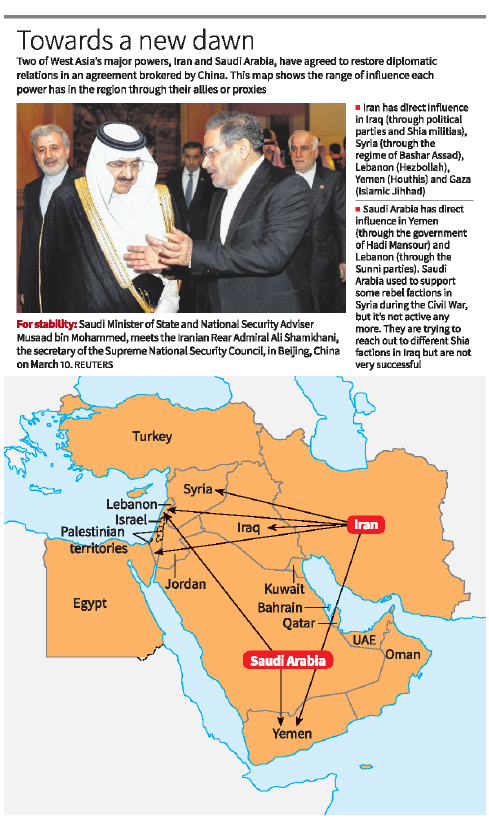Description

Disclaimer: Copyright infringement not intended.
Context: Saudi Arabia and Iran, two of West Asia’s major powers that have been at odds with each other for decades, agreed to restore diplomatic relations in an agreement brokered by China.
Details:
Background:
- The rivalry between the two dates back to pre-revolution Iran when they competed with each other for regional dominance.
- After the 1979 revolution brought down the Iranian monarchy and turned the country into a Shia theocratic republic, sectarian and ideological flavours were added to the mix.
- In recent times, it had turned into a cold war with both sides supporting their proxies across West Asia.
- Formal ties between them collapsed in 2016 after the Saudi embassy in Tehran was overrun by protesters following Riyadh’s execution of a Shia cleric. N
- ow, under China’s mediation, they have agreed to start a new beginning. If peace holds, it could have far-reaching implications for regional security, stability and geopolitics.
.jpeg)
What are the terms of the agreement?
- Finer details of the agreement are yet to be unveiled.
- Iran has agreed to prevent further attacks against Saudi Arabia, especially those from the Houthi-controlled parts of Yemen (Iran backs Houthis, a Shia militia in Yemen while the Saudis back the government forces).
- Saudi Arabia, on its part, agreed to rein in Iran International, a Farsi news channel that is critical of the Iranian regime (which the Iranian intelligence has termed a terrorist organisation).
Why did Saudi Arabia reach out to Iran?
- West Asia has been undergoing strategic realignments in recent years.
- In 2020, the UAE became the first Arab country to normalise relations with Israel in a quarter century.
- In the following years, Israel and Arab countries deepened their partnerships.
- In 2021, Saudi Arabia, the UAE and their allies decided to end their failed blockade of Qatar.
- The U.S. was also trying to broker a normalisation agreement between Saudi Arabia and Israel.
- One of the key drivers of these realignments is the U.S.’s deprioritisation of West Asia.
- America’s allies in the region see the twin realities of a power vacuum created by the U.S.’s deprioritisation and the challenge posed by Iran’s rise.
- To address these problems, the U.S. wanted to bring the two pillars of its West Asia policy — Israel and the Arab world — together against Iran so that the American alliance system in the region would not be disrupted.
- Additionally, relations between Saudi Arabia and the U.S. have been rocky in recent years.
What led Iran to accept the deal?
- Iran is going through one of the toughest phases of economic isolation and domestic pressure.
- Iran wanted Chinese investments and support for the rial.
- So, while struggling with isolation and sanctions, a deal with Saudi Arabia, under China’s mediation, could open economic lifelines for Iran.
- And strategically, Iran knows that such a deal could complicate American effort to rally Arab countries and Israel against it.
- So economically and strategically, a reconciliation is beneficial for Tehran, at least in a tactical sense.
What does China gain from the deal?
- China has economic, regional and strategic interests in playing the role of a peace broker in West Asia.
- China is the world’s largest oil buyer and stability in the energy market is essential for its continued rise.
- Regionally, the agreement marks China’s arrival as a major power in West Asia
- Besides, China is also trying to send a clear message to countries in the Global South. While the U.S. is busy rallying the Western world to arm Ukraine to push back Russia and weaken Moscow through sanctions, China is quietly brokering peace in the Global South.

How does the U.S. look at the deal?
- S. officials have welcomed the reconciliation.
- But from a strategic point of view, the U.S. would be facing unpleasant questions about the agreement. The Iran nuclear deal is practically dead. The U.S. wants Saudi Arabia to normalise ties with Israel and put up a joint front against Iran.
- But now, when it looks at the region, it sees an ally (Saudi Arabia) drifting further away, a rival who it wanted to contain (Iran) making new friends and its global challenger (China) spreading and deepening its influence in a region which the U.S. had dominated since at least the Suez War of 1956.
How the situation in parts of the Middle East where Iran and Saudi Arabia have been involved in proxy conflicts could be affected by a Beijing-brokered deal?
Yemen: Restored ties between Riyadh and Tehran could facilitate agreement between Saudi and the Houthis.
Syria: The Saudi-Iranian deal comes as Arab isolation of Assad is thawing. Saudi has said more engagement could lead to Syria’s return to the Arab League. Syria’s foreign ministry welcomed the deal as an “important step” that could boost regional stability. The opposition’s umbrella body did not comment.
Lebanon: Lebanon has since sunk deeper into financial meltdown and now faces an unprecedented political crisis, with no president for months and a cabinet operating with limited powers. The rapprochement between Tehran and Riyadh has sparked hope that paralysis could end.
Iraq: Iraqis hope for a general regional detente that would allow their country to rebuild, instead of being destabilised by U.S., Gulf Arab and Iranian score-settling.
|
PRACTICE QUESTION
Q) Discuss the implications of the restoration of relations between Saudi Arabia and Iran on situations in parts of the Middle East. (250 words)
|

https://epaper.thehindu.com/ccidist-ws/th/th_delhi/issues/28544/OPS/GT5B0205G.1+GBDB02AV0.1.html















